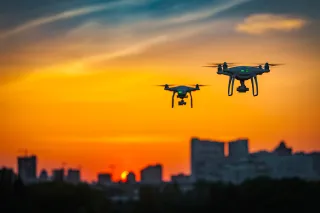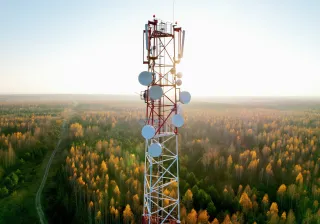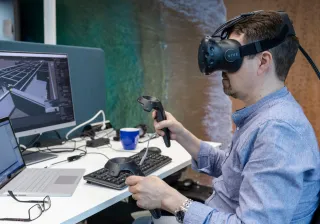The prototype of the ConIoT project of the VTT Technical Research Centre of Finland warns of hazards on construction sites.
What if work clothes could not only protect their users but also warn them of an approaching work machine or urge them to take a break when they are tired? The product development department of work clothing company Dimex is currently producing prototype jackets with wash resistant LEDs which are sewn onto the jacket and which warn their wearers of hazardous situations.
Since the beginning of 2019, the ConIoT project coordinated by VTT Technical Research Centre of Finland has been investigating how to make construction sites safer using smart clothing and data analytics. The project is now in its final stages, and the fruits of the development work will soon be tested out in real life.
‘I hope that we will soon be able to gather user experiences from construction sites, says researcher Satu-Marja Mäkelä from VTT.
In the construction sector, occupational safety is a major challenge. Accidents involving falling down or falling over are more common than in other sectors, and strenuous working positions can be harmful for the body. Product development-focused Finnish work clothing manufacturer Dimex had for a long time been considering how it could improve the safety of the users of its products by taking a step beyond the current requirements of safety certifications.
‘People have been talking about smart clothing for a decade already, but there still isn’t anyone who is selling them. We were thinking over how we could use the useful data produced by smart clothing to boost occupational safety,’ says Tuire Krogerus, owner-manager of Dimex Oy.
This dialogue between Dimex and VTT researchers gave birth to the ConIoT project. Satu-Marja Mäkelä started looking for other companies that would be interested in improving occupational safety in the construction sector with the help of IoT solutions. A representative group of construction sector actors joined the ConIoT project, which received funding from Business Finland. The project includes the construction company Fira, scaffolding and weather protection supplier Telinekataja Oy, precast concrete manufacturer Lipa-Betoni, construction software company Congrid, IoT platform developer iProtoXi and IT company Sofor. The AI expertise within the project is important for identifying hazardous situations from the data produced by the wearable sensors.
AI systems crunch through the measurement data
For a long time already, pilots have been carried out of different construction site systems, which locate the user and warn of, for example, approaching machinery or being located underneath a heavy load. Such positioning technology is also utilised in the ConIoT project, in which the focus of the development work has been on the analysis of the movement data produced by smart clothes. The project also takes a novel approach in utilising the work clothing not only as a location for sensor placement but also as a user interface.
‘The most common user interface in previous pilots has been a mobile phone, which is a well-known occupational safety risk on construction sites,’ explains Satu-Marja Mäkelä.
The most visible output of the ConIoT project is a smart work jacket equipped with an LED optical fibre. However, it is only the most obvious part of a much larger system for improving construction site safety. It is the IoT system in the background that makes the smart jacket smart. Its components include a data communication infrastructure that collects location data from the construction machinery and reads the sensor data generated by the clothing. A data analytics and a reporting system are required for processing the data, and this system both distributes the processed data in an appropriate format to those who need it and also delivers warnings on hazardous situations to the correct recipient.

The project also utilises artificial intelligence. Mäkelä explains that research data for the project has been collected at the Innopoli 4 construction site for the new VTT offices. Data has been collected from the work activities of cleaners, painters, air conditioning installers and supervisors. The acceleration sensors sewn into the jacket and trousers and the positioning sensor in the pocket provide a continuous flow of data throughout the working day. A total of 1700 hours of data were used by researchers.
In controlled conditions, the AI technology in use recognises different kinds of work tasks from the data with almost 90% accuracy. Mäkelä is satisfied with the results. For many users, even the familiar fitness watches in use nowadays are not yet able to automatically identify all types of sports.
‘Identification of different activities on the construction site is much more difficult. It is not easy to distinguish whether someone is spreading filler or painting.
The next step is to teach the AI to recognise different exceptions to normal working patterns.
- The number request of our backers is the ability to recognise work at heights and any deviations in the normal movement patterns for this work, says Mäkelä.
This allows the system to alert users of incorrect working practices, for example, and thus prevent falls.
Aiming to identify hurried actions
The aim is also to learn to use the sensor data to identify hurried work.
‘Hurry is a safety risk, and it is also a quality risk. People in a hurry not only stumble and fall but also botch the work they are doing. This means poorer work results,’ says Satu-Maria Mäkelä.
The system could advise individual employees to relax their pace of work and, for example, inform the site management where there is a need for additional hands.
At the beginning of the project, the researchers carried out an online survey of wearable technology among the members of the Finnish Construction Trade Union. The results of the over 4 000 responses were encouraging: half of the respondents were either very interested or fairly interested in using measuring devices in their work. Privacy issues were the largest concern among respondents. The information produced by the system regarding hazardous locations, hurry, and progress of work would be valuable for the management, but the employees fear that the system would also become a monitoring tool.
‘Employees' levels of trust play a key role when planning new occupational safety solutions based on sensor data,’ Mäkelä emphasises.
At its best, the development of such a system can benefit everyone on the construction site, from the worker on the ground right up to the top management of the company. When Mäkelä went to present the project to shop stewards from the construction sector, new uses for the system were immediately put forward.
‘They told me that the foreman often can’t be found on the site when problems arise.
An automatic positioning sensor on their coat would make finding them a lot easier than the current task of looking around for the white helmet.
‘This is exactly how such systems should be developed, not just as a tool for the company management. If everyone benefits, they are more likely to be used.’
The ConIoT research project led by VTT has been a positive experience for Dimex. Tuire Krogerus believes that it would not have been possible anywhere else to get the opportunity to work with such different kinds of companies.
‘It is inspiring to see how much technical expertise and skills are to be found in this country,’ says Krogerus.
The best thing is that the work has also produced results.
‘I already know that when the project finishes at the end of this year, we will have a clothing prototype that improves occupational safety in the construction sector.’

Big launch already in the pipeline
Krogerus says that plans are in place for next spring to launch the smart clothing developed in the project for use by the general public. As well as clothing expertise, the sensor and software expertise of the partnering companies is also needed.
‘We can't do this alone.’
Fortunately, the ConIoT project has given an opportunity to practice collaborating with construction companies, sensor suppliers and software developers.
‘This project has certainly proven wrong the assumption that Finnish companies are not able to work together,’ Krogerus says with a laugh.
Although commercialising wearable technology is much more challenging than selling normal clothing, Krogerus is confident that the demand is there. The market breakthrough is inevitable, sooner or later.
‘Occupational safety is a supertrend. I don't think this is going to be a year in which investments in occupational safety will decrease.’
Researcher Satu-Maria Mäkelä points out that the construction sector is not the only sector that would benefit from wearable technology.
‘This technology is suitable for all areas of physical work, from mechanical engineering to cleaning and elderly care.’
Text: Petja Partanen
ConIoT project facts
The aim of the ConIoT project is to improve occupational safety and well-being in the construction sector by utilising information-intensive solutions based on the Internet of Things (IoT).
The project is funded by Business Finland, participating companies, and VTT Technical Research Centre of Finland
Project participants: Congrid, Dimex, Fira, iProtoXi, Lipa-Betoni, Sofor, Telinekataja and VTT




